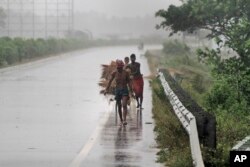A weakened Cyclone Fani struck Bangladesh Saturday after leaving a trail of destruction Friday in India’s eastern Odisha state.
Authorities said they are investigating at least 12 reported deaths in India and at least four in Bangladesh, although a significant human disaster appears to have been averted.
In a 24-hour period before the storm made landfall, an unprecedented 1.2 million people in India were evacuated, India’s National Disaster Response Force said, averting a greater loss of life. In neighboring Bangladesh, another million people were moved to safety.
Fani had been downgraded to a depression as it swept inland over Bangladesh. “The fear of a major disaster is mostly over, as it has weakened,” said Bangladesh Meteorological Department Director Shamsuddin Ahmed.
Authorities in India were assessing the damage inflicted by Fani, which strengthened for days over the northern parts of the Bay of Bengal before tearing into Odisha. The popular seaside tourist town of Puri was extensively damaged Friday by wind gusts of up to 200 kilometers per hour, tearing off roofs, snapping power lines and uprooting trees.
Eastern India is no stranger to deadly storms. In 1999, a super-cyclone hit Odisha, killing more than 10,000 people. Four years later, the toll was significantly lower when Cyclone Phailin hit the state. Because of improved forecasting and evacuation procedures, the death toll from Fani is expected to be even lower.
On Tuesday, Fani became the strongest storm in the north Indian Ocean this early in the season, passing Cyclone Nargis, which killed more than 100,000 people in Myanmar in 2008.
The north Indian Ocean cyclone season does not have fixed start and end dates like the Atlantic hurricane season. Instead, it has two main periods of activity: late April to early June, and October and November.
Fani is the first cyclone of the 2019 season.






